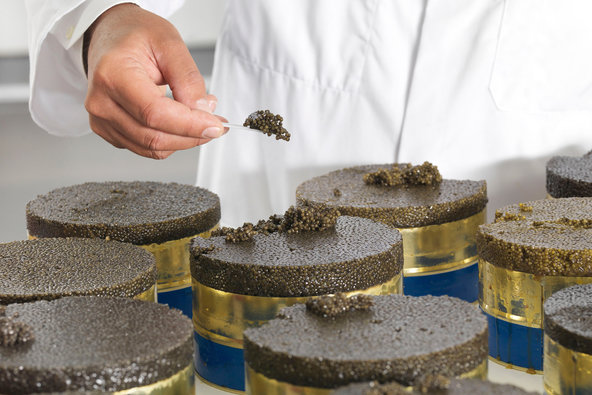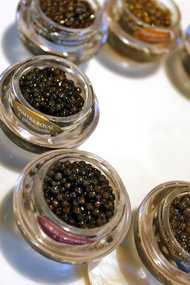
Caviar has lost its national identity.
Over the years, caviar-producing wild sturgeon in the Caspian Sea have been poached, smuggled and overfished to the brink of extinction. Sturgeon fishing fell under a series of strict international quotas and in 2008 was subjected to a global ban by the Convention on International Trade in Endangered Species. The only caviar on the market since then comes from tame varieties farmed in concrete basins and cages. The result is a global free-for-all in which caviar’s country of origin has no meaning, and only the best eggs win.
“Once upon a time, great caviar meant the Caspian,” says Armen Petrossian, owner of the Petrossian restaurant and boutique in the Seventh Arrondissement in Paris. Now, he says, “geography and nationality do not count.” Yet business is so good that sturgeon are raised on about 90 farms in more than 20 countries, in places as varied as Israel, the United States, China, Uruguay and just about every country in Europe.
To prove that caviar is stateless, Petrossian arranged an ambitious tasting for T and another writer — the French food author Jean-Claude Ribaut — over lunch. Twelve different caviars on four silver ice stands were laid out. Each stand held three grades — from the lowly “royal” to the midgrade “imperial” and the superior “special reserve” — of each species. He told his guests to try one at a time in the order he chose. Using a small mother-of-pearl spoon for each variety, they loaded gobs of caviar onto blinis and washed them down with vintage Deutz Champagne served in tall, narrow flutes. By the second round, they were spooning the caviar like jam into their mouths.
Petrossian is probably the best-known caviar merchant in the world. His father and uncle opened the Paris boutique 94 years ago. But at the tasting, when asked the origin of the caviars, he knew only some of them. He had to peek at the labels glued to the bottom of the tins to identify the rest. The Beluga was Bulgarian, he said; the Baeri French; the Osetra Italian. Transmontanus, which comes from white sturgeon, is his best-selling caviar, produced in the tiny town of Elverta in the Sacramento Valley in California. “The only guide we use to judge quality is our senses,” Petrossian says. “Only taste, smell, color, brilliance and texture of each species count.”
The search for the best caviar requires dogged investigation and years of experience. The same farm can produce caviar of different qualities, depending on variables like the temperature and purity of the water and the season of the year. A caviar that tastes like earth comes from sturgeon raised in water that isn’t crystal clear, for example. Sturgeon eggs from Bulgaria are best in the spring, when the mountain air and water is still cold. Petrossian likens the selection task to choosing gemstones. “You buy a diamond because of its beauty, not the country where it was mined.”

At Kaviari, a Paris-based wholesale supplier to hotels, restaurants and fine gourmet shops, the approach is more single-minded. There is no beautiful restaurant, only an antiseptic, white-walled, refrigerated room for serious tastings with a stainless steel table and no place to sit. (Since this is France, Champagne is served, even in the morning).
Even starred chefs like Yannick Alléno, Guy Savoy and Jean-François Piège are required to wear plasticized paper coats, hairnets and shoe coverings when they visit. They come to taste and choose their caviar from Bruno Higos, a master taster with more than three decades’ experience. One morning, Higos opened four 1.8-kilo tins of caviar for an informal tasting: a Transmontanus and a Baeri from Italy, an Osetra from Bulgaria and a Schrenki from China.
Caviar has long stood for seductive luxury. So Kaviari, Petrossian and other caviar dealers have come up with creative ways to promote their products now that they can no longer sell the luscious caviar fished from the Iranian and Russian borders of the Caspian Sea.
Kaviari offers individual caviar servings in a slim “line” of 15 grams of caviar and a plastic spoon in a narrow, colorful tin that starts at 25 euros. Bars serve it along with a glass of Champagne or a shot of vodka; private companies can order personalized versions of it for special events like New Year’s Eve.
Petrossian, meanwhile, has begun processing and marketing tiny black lobster eggs under the name “Bijou de la Mer” — jewel of the sea. The eggs release the taste of iodine and salt when their hard skins are crushed between the teeth. “Papierusse,” a thin sheet of vacuum-packed pressed caviar, and its tinned, pressed caviar with the consistency of thick jam, work well with soft-boiled eggs, boiled baby potatoes or in a caviar sandwich. Petrossian also markets a host of unrelated products under the label: pomegranate juice, smoked scallops, royal crab claws, herbal teas, borscht, vodka and even chocolates, honey, olive oil and balsamic vinegar. Its pièce de resistance this season is an artisan-crafted, limited-edition metal tin that measures 18 inches in diameter and resembles an oversize hat box. It is large and sturdy enough to be used as a coffee table. It costs 1,000 euros even when empty; if filled to the brim with caviar, smoked fish, vodka and other delicacies, the price can rise to 10,000.
Despite merchants’ clever attempts to deflect attention from caviar’s origins, there are ways to identify and rank caviar by region and country. France, where sturgeon are farmed in manmade basins in the Sologne, Aquitaine and Charente regions, was a pioneer in sturgeon farming. But it is not making the best caviar. That’s because French farmers raise mostly Baeri — a small sturgeon species which produces small eggs — to be farmed. The eggs can lack firmness and the taste does not linger long on the palate.
China, meanwhile, is moving forward rapidly in caviar farming, and eventually could come to dominate it, thanks in part to freshwater Lake Hangzhou. The water of this 221-square-mile lake is pure, its currents strong. Sturgeon are housed in huge cages that can be raised and lowered to a depth of 164 feet to keep them cold. “It’s a great beginning, and it’s approaching what you used to find in the Osetra or the Caspian,” says Raphaël Bouchez, Kaviari’s president.
The unknown is whether sturgeon, which take 10 or more years to mature, will ever again be fished from the Caspian. But one can dream. Indeed, the Chinese Schrenki looks exactly like the translucent golden-grey Osetra of the deep waters of the Caspian. The firm, fatty texture of the eggs is the same. Its taste is nutty and stays long on the tongue. Perhaps because it is also so beautiful, it is the choice of France’s great chefs. But Higos, the taster at Kaviari, still remembers fine Iranian Beluga and Osetra from the days when he went to Iran to buy. “When the first box arrived, I said to myself, ‘Ah, Iran,’” Higos says of the Schrenki. “Alas, it’s not the taste of the golden caviar of the Caspian. I was very disappointed.”
Additional reporting by Assia Labbas.

